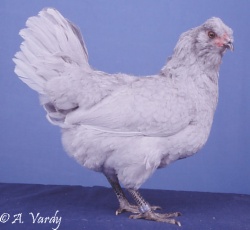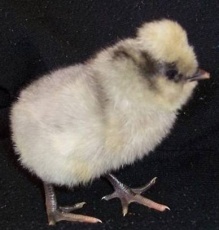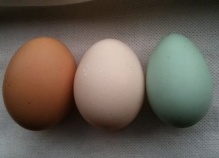Difference between revisions of "Araucana"
| Line 1: | Line 1: | ||
| − | [[Image:Araucana.jpg|250px]] [[Image:Araucana chick.jpg|219px]] | + | [[Image:Araucana.jpg|250px]] [[Image:Araucana chick.jpg|219px]] [[Image:Araucana egg colour.jpg|219px]] |
Photo left: Andy Vardy. Large lavender female owned by RG Lindsay 2004 | Photo left: Andy Vardy. Large lavender female owned by RG Lindsay 2004 | ||
| − | Photo | + | Photo middle: Pengilda - Backyard Poultry Gallery |
| + | |||
| + | Photo right: Pacer - Backyard Poultry Gallery, Araucana egg on right | ||
Revision as of 20:48, 16 June 2013
Photo left: Andy Vardy. Large lavender female owned by RG Lindsay 2004
Photo middle: Pengilda - Backyard Poultry Gallery
Photo right: Pacer - Backyard Poultry Gallery, Araucana egg on right
Araucana
This breed is well known for its coloured eggs – from blue, through green to olive-green. The shell colouring is distinctive in that the blue is all through the shell, not just laid on the outside as with brown coloured eggs. All other breed that lay blue eggs have achieved this by crossing with Araucanas.
Origin: Chile
Classification: Light Breed, Soft Feather
Colours: Lavender, Blue, Black, White, Cuckoo and Old English Game Colours
Eggs: Vary in colour from a Skye Blue through to Olive Green. For some years Araucana eggs were promoted as the ‘Low Cholesterol’ egg, so healthier than other eggs, however this has been found to be a fallacy – cholesterol levels are similar for all eggs.
Egg Colour Chart, available from The Araucana Club of Great Britain (see below for address) or on Ebay.
Comb: Pea Comb - a triple comb, resembling three small single combs joined together at the base and rear, but distinctly divided, the middle of one being the highest.
Comments: An alert, active bird with a small pea comb and thick muffling, beard and ear muffs on the face. There is a small crest, well back from the eyes. Ear lobes and wattles are small.
History: The Araucana originally comes from the Arauca Provence of Northern Chile, from before the time of the Spanish conquest, and are a mix of two breeds – the Collonca (a blue egg laying, rumples, clean –faced chicken) and the Quetros (a pinkish-brown egg layer with tail and ear tufts). Nowdays Araucana come as ‘rumpless’ or ‘rumped’. Rumpless do not have the last spinal vertebrae, an uropygium (parson’s nose) or tail feathers, while the rumped varieties have a normal tail. In America only the rumpless birds are recognised as Araucana, but here in Australia, as in the United Kingdom, both rumped and rumpless are recognised. The large ear tufts of the Quetros survive as a trait of Araucana, but usually they are not nearly as extravagant in size as the original.
Exhibition: A good exhibition bird should have a long, deep body, with horizontal back, wings large and strong, with a well developed tail at a 45 degree angle. The head should be moderately small, the beak strong and stout and the eyes bold. The comb should be a small pea comb, and face covered with thick muffling, beard and ear muffs. The ear lobes should be small and covered with muffling and the wattles small to absent, the crest small and set well back from the eyes. Legs should be of medium length, strong and set well apart. It should have no feathers on its shanks and four straight well spread toes. The rumpless variety should have no parson’s nose, with the tail entirely absent and the saddle feathers flowing over the rump.
Suitability: Araucana are hardy birds and do well in most settings. Although they are generally good layers and there are records from the first half of the 20th century of Araucana being able to lay up to 240 eggs per year, these days that is unlikely. They are a breed that can go broody (however not all show this tendancy) and make good mothers. Some have a tendency to flightiness.
Bantams: The bantam is an exact miniature of the large fowl.
Forum Links:
Internet Links:
Crested Breed Club of Australia


